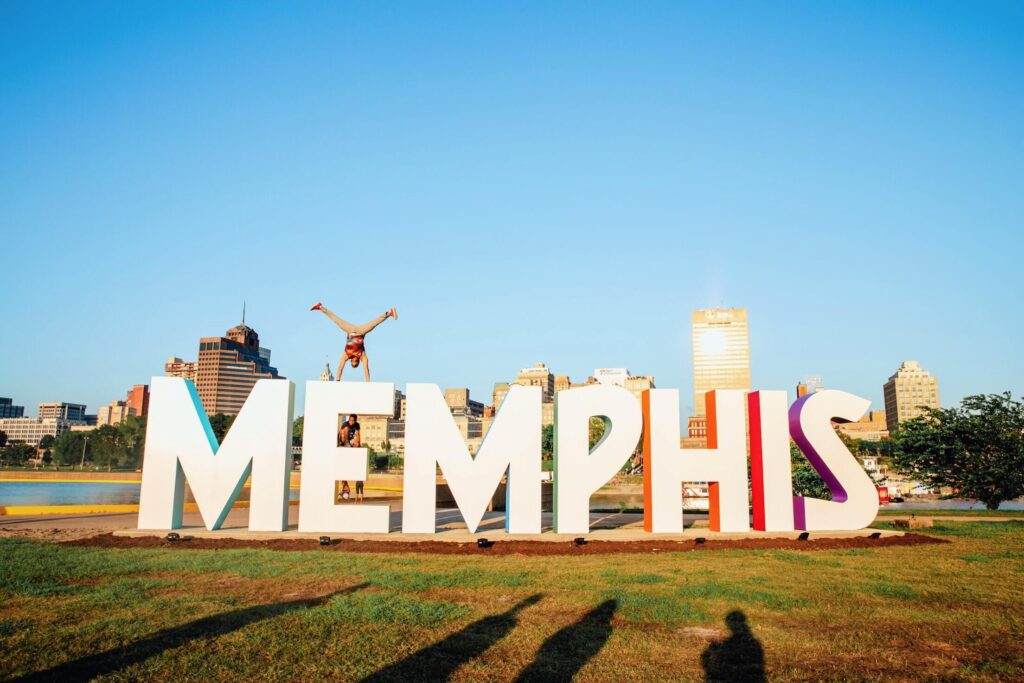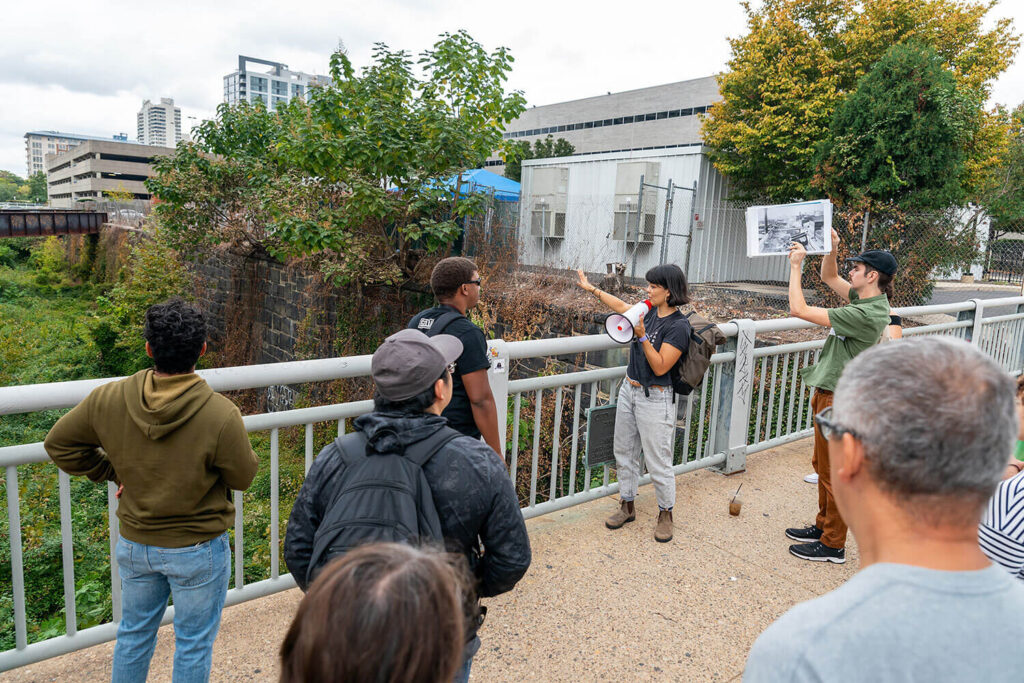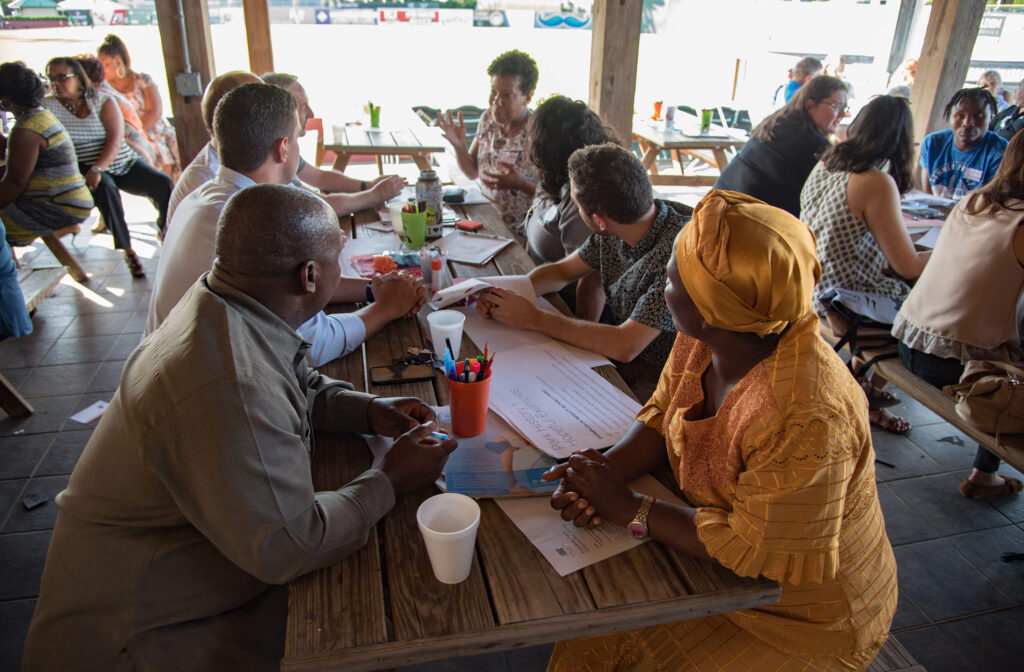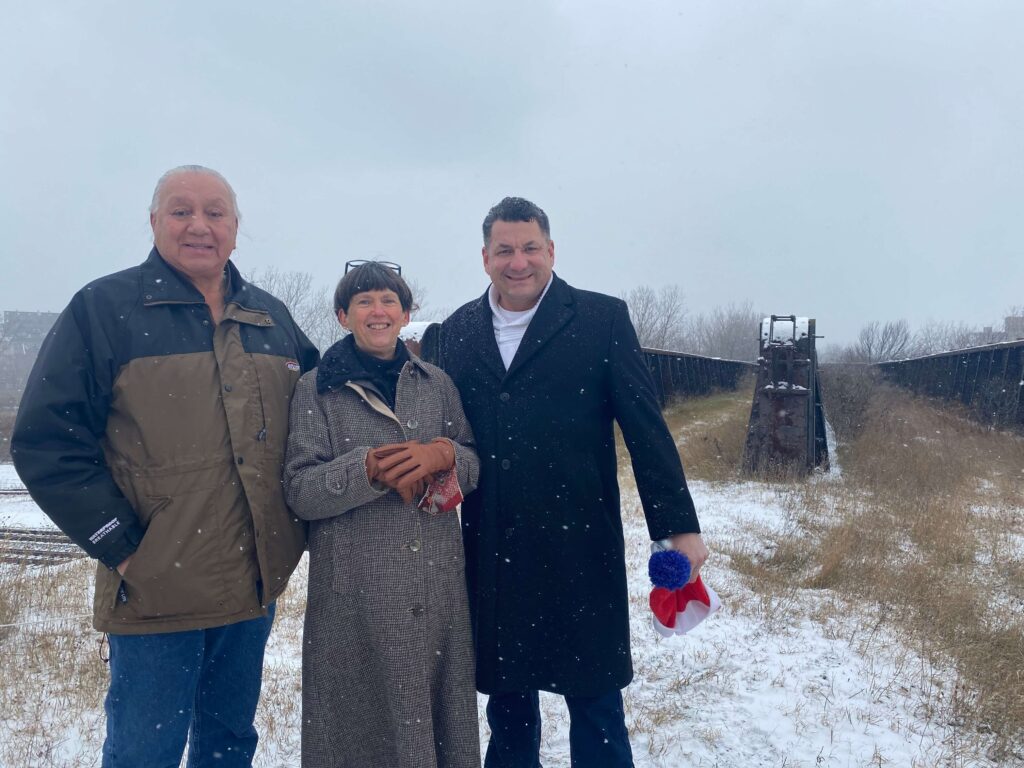Would you like to showcase your own work to embed equity in your infrastructure reuse project?
Reconciling with a City’s History

Credit: Memphis River Parks Partnership
The Memphis River Parks Partnership manages, operates, and activates five connected riverfront park districts totaling 250 acres of parkland along the Mississippi River. Currently, the biggest capital investment of the Partnership is Tom Lee Park, the most visible riverfront park adjacent to Downtown Memphis.
For many years, Memphis turned its back on its riverfront. The riverfront was used for industry, logistics, transportation, as a city dump and more. Over the past century, more than 20 riverfront plans were written and left largely unexecuted. To change this, and to take full advantage of the potential of this remarkable public resource, the incoming Mayor Jim Strickland created a Riverfront Task Force in 2017. The task force engaged Studio Gang to produce the Memphis Riverfront Concept, a visionary guiding document for a connected, catalytic and fun “Riverfront for Everyone”. The Partnership was created in 2018 with a mandate to execute the concept.
A necessary step in the reuse of the riverfront is reconciling symbols of Memphis’s racial history. In 2013, as the result of community action and a unanimous Memphis City Council vote, three Memphis parks, each honoring–by name and/or physical monument–former Confederate generals, were renamed. However, the Confederate statues remained untouched until 2017 when the City Council sold the three parks in question to Memphis Greenspace–a non-profit created specifically for this purpose–who facilitated their immediate removal. This community-driven action skirted the Tennessee Heritage Protection Act, a state law that prohibits the removal, relocation, or renaming of memorials on public property. What followed was a frenzy of lawsuits from the Sons of the Confederate Veterans. This reaction made it clear there is still much reckoning the city needs to do with slavery and its racial history.
While the Partnership was not involved in the political turmoil surrounding the park decisions, they recognized that just renaming the parks and removing the memorials would not by itself create welcoming, inclusive community spaces in Fourth Bluff Park (formerly Confederate Park) and River Garden (formerly Jefferson Davis Park). Given community feedback, it was important for the African American population, a majority in Memphis, to feel and see that the city was working to reconcile history. In alignment with their mission, the Partnership saw the opportunity to address Memphis’s racial history at these parks as twofold: to bridge historical realities and present peoples and transform the riverfront to offer accessible public park space for all Memphians.
Investments in River Garden transformed the once sparse park into an integrated landscape with new plantings, spaces to gather, and paths to walk and signaled a new landscape for all Memphians to see themselves in. Today, River Garden is one of the most popular parks on the waterfront. Immediately after the construction of Fourth Bluff Park, the Partnership collaborated with local artists on “Peace Project,” an integrated soundscape that looped guided meditations and relaxing soundtracks throughout the park. In the midst of COVID, this installation offered a safe refuge and relaxing space for the public to gather. Further, working with local artists helped rewrite the story and lived experiences of the park.
Another strategic collaboration was with the Memphis Grizzlies basketball team. The official playoff watch parties were held in Fourth Bluff Park. A joyous, diverse gathering of Memphians on a space that once memorialized division. Watch parties in the park became an extremely successful move in bringing Memphians together in support of a common interest. Today, River Garden and Fourth Bluff Park are the backdrop for expansive lineups of free and public events initiated by the Partnership. Through design, strategic partnerships, and community engagement Memphis River Parks partnership transformed these two small, but mighty spaces. The transformation of River Garden and Fourth Bluff Park set the stage for Tom Lee Park, now under construction. Tom Lee Park is slated to be the centerpiece of Memphis’s waterfront, tying together history, environment, and public parklands along the Mississippi.
In Memphis, and especially along the riverfront and in public spaces, the history of naming, memory, and acknowledgement is complicated. Such was the case with the story of Tom Lee. Tom Lee Park is named in honor of the heroic Tom Lee, an African American river worker who in 1925 rescued 30 white individuals from a capsized boat in the Mississippi. Until this park, his heroic story was seldom acknowledged in the history of Memphis. With the transformation of public land into community activated vibrant park spaces comes greater commitment by the Partnership in acknowledging the enduring impacts of history and pushing towards more inclusive, community-driven public spaces.
Project Org
Memphis RiverfrontRelated Toolkit Section
Examine HistoryRelated Tool
CONNECT THE DOTSThe Memphis River Parks Partnership manages, operates, and activates five connected riverfront park districts totaling 250 acres of parkland along the Mississippi River. Currently, the biggest capital investment of the Partnership is Tom Lee Park, the most visible riverfront park adjacent to Downtown Memphis.
For many years, Memphis turned its back on its riverfront. The riverfront was used for industry, logistics, transportation, as a city dump and more. Over the past century, more than 20 riverfront plans were written and left largely unexecuted. To change this, and to take full advantage of the potential of this remarkable public resource, the incoming Mayor Jim Strickland created a Riverfront Task Force in 2017. The task force engaged Studio Gang to produce the Memphis Riverfront Concept, a visionary guiding document for a connected, catalytic and fun “Riverfront for Everyone”. The Partnership was created in 2018 with a mandate to execute the concept.
A necessary step in the reuse of the riverfront is reconciling symbols of Memphis’s racial history. In 2013, as the result of community action and a unanimous Memphis City Council vote, three Memphis parks, each honoring–by name and/or physical monument–former Confederate generals, were renamed. However, the Confederate statues remained untouched until 2017 when the City Council sold the three parks in question to Memphis Greenspace–a non-profit created specifically for this purpose–who facilitated their immediate removal. This community-driven action skirted the Tennessee Heritage Protection Act, a state law that prohibits the removal, relocation, or renaming of memorials on public property. What followed was a frenzy of lawsuits from the Sons of the Confederate Veterans. This reaction made it clear there is still much reckoning the city needs to do with slavery and its racial history.
While the Partnership was not involved in the political turmoil surrounding the park decisions, they recognized that just renaming the parks and removing the memorials would not by itself create welcoming, inclusive community spaces in Fourth Bluff Park (formerly Confederate Park) and River Garden (formerly Jefferson Davis Park). Given community feedback, it was important for the African American population, a majority in Memphis, to feel and see that the city was working to reconcile history. In alignment with their mission, the Partnership saw the opportunity to address Memphis’s racial history at these parks as twofold: to bridge historical realities and present peoples and transform the riverfront to offer accessible public park space for all Memphians.
Investments in River Garden transformed the once sparse park into an integrated landscape with new plantings, spaces to gather, and paths to walk and signaled a new landscape for all Memphians to see themselves in. Today, River Garden is one of the most popular parks on the waterfront. Immediately after the construction of Fourth Bluff Park, the Partnership collaborated with local artists on “Peace Project,” an integrated soundscape that looped guided meditations and relaxing soundtracks throughout the park. In the midst of COVID, this installation offered a safe refuge and relaxing space for the public to gather. Further, working with local artists helped rewrite the story and lived experiences of the park.
Another strategic collaboration was with the Memphis Grizzlies basketball team. The official playoff watch parties were held in Fourth Bluff Park. A joyous, diverse gathering of Memphians on a space that once memorialized division. Watch parties in the park became an extremely successful move in bringing Memphians together in support of a common interest. Today, River Garden and Fourth Bluff Park are the backdrop for expansive lineups of free and public events initiated by the Partnership. Through design, strategic partnerships, and community engagement Memphis River Parks partnership transformed these two small, but mighty spaces. The transformation of River Garden and Fourth Bluff Park set the stage for Tom Lee Park, now under construction. Tom Lee Park is slated to be the centerpiece of Memphis’s waterfront, tying together history, environment, and public parklands along the Mississippi.
In Memphis, and especially along the riverfront and in public spaces, the history of naming, memory, and acknowledgement is complicated. Such was the case with the story of Tom Lee. Tom Lee Park is named in honor of the heroic Tom Lee, an African American river worker who in 1925 rescued 30 white individuals from a capsized boat in the Mississippi. Until this park, his heroic story was seldom acknowledged in the history of Memphis. With the transformation of public land into community activated vibrant park spaces comes greater commitment by the Partnership in acknowledging the enduring impacts of history and pushing towards more inclusive, community-driven public spaces.
Share this Case Study


